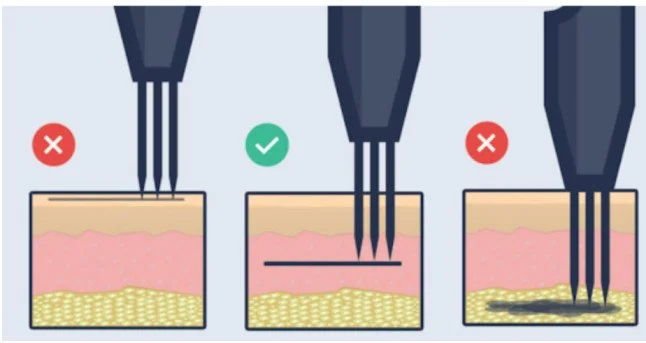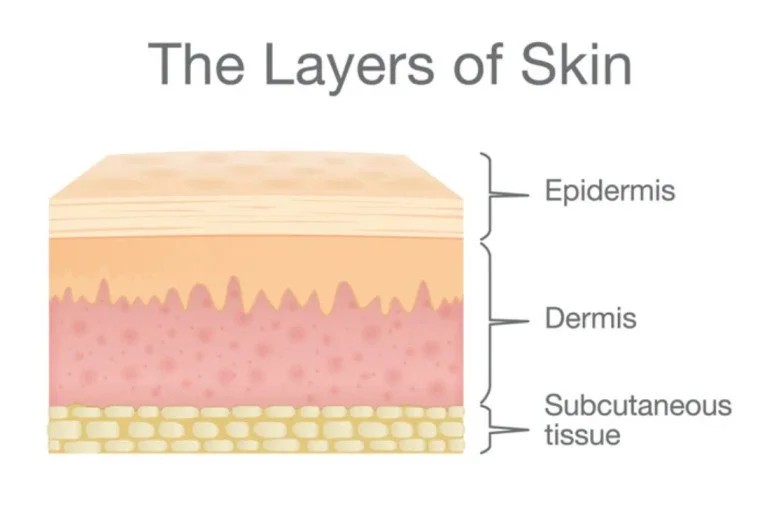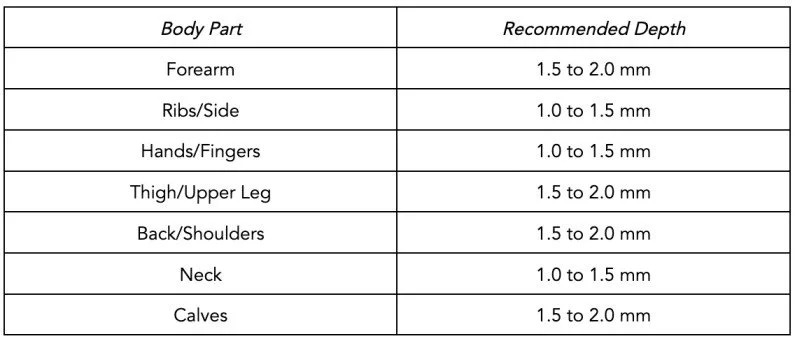How Deep Do Tattoo Needles Go? A Complete Guide
Have you ever wondered how deep do tattoo needles go into the skin? As a tattoo artist, it is one of the most important things to focus on.
Every design, no matter how small or detailed, depends on hitting the right layer of skin. If the needle goes too shallow, the ink will sit in the wrong place and fade quickly. However, if it goes too deep, it can damage the skin and leave scars.
In both cases, it’s on the tattoo artist.
Remember, finding that perfect balance is what separates clean, long-lasting tattoos from ones that age poorly.
How Deep Do Tattoo Needles Go on Average?
Source: Tattooing 101
If you’re wondering how deep tattoo needles go, on average they penetrate about 1 to 2 millimeters into the skin. This depth is enough to reach the dermis, which is the layer that holds ink securely. If the ink stays only in the epidermis, it will fade as the skin sheds.
On the other hand, if the needle goes too deep, it can cause tattoo scabbing, scarring, blowouts, and unnecessary pain. That is why most professional artists are for this 1-2 mm range.
The exact depth, however, is not the same in every situation. It changes based on machine type, body area, and skin thickness. For example, rotary machines usually give smoother and more consistent depth control, while coil machines require more adjustment.
Understanding Skin Anatomy
Source: Skinkraft
Before any needle touches the skin, an artist must understand the layers they’re working with. The skin has three main layers: the epidermis, the dermis, and the subcutaneous tissue. The epidermis is the outermost layer, the dermis is the middle layer, and the subcutaneous tissue is the fatty layer at the bottom.
For fine or small tattoos to last, the ink must sit in the dermis layer. The dermis is stable, meaning it doesn’t shed like the epidermis. When ink is placed here, it stays locked in place and gives tattoos their durability and crisp lines.
If ink only reaches the epidermis, it will fade or disappear entirely as the skin regenerates. On the other hand, going too deep into the subcutaneous tissue can cause problems. Ink in this layer spreads unevenly, leading to blowouts, blurred lines, and scars.
How to Set Tattoo Needle Depth?
The goal is to place the ink in the dermis, the middle layer of skin, where it can stay stable without spreading. But how do you make sure your setup is correct before you start tattooing? Here’s how:
1. Standard Setup Guidelines
Most artists adjust their machine so that the needle protrudes about 1 to 2 millimeters past the tube tip. This is usually the sweet spot for reaching the dermis without damaging the deeper layers.
When setting up your machine, the needle should typically protrude about the thickness of a nickel (around 1.5–2 mm) when pressed against the skin.
2. Tattoo Needle Depth for Shading
The right depth also depends on the type of work you’re doing.
For crisp, bold lines, the needle should consistently hit the dermis at a slightly firmer depth to ensure solid saturation.
Shading requires softer pressure and careful control to build gradients without overworking the skin. A softer hand paired with a controlled stroke helps blend smoothly and prevents blowouts.
3. Tattoo Needle Depth for Lining
As a beginner, the tattoo needle depth for lining should be steady and controlled. Lining requires slightly more precision than shading because the needle has to penetrate deep enough to create lasting outlines.
A safe starting point is about 1.5 mm into the skin, with consistent hand pressure throughout each stroke.
Source: Pinterest
Tattoo Needle Depth Chart
A tattoo needle depth chart is a quick reference that shows how deep needles should go for lining, shading, and different skin types. It helps artists, especially beginners, maintain consistency and avoid common mistakes like blowouts or fading.
Tattoo Needle Depth for Different Body Parts
Here’s a general guideline for the tattoo needle depth for different tattoo locations:
Pro Tip: Always stretch skin, check client comfort, and test on practice skin before working on tricky areas.
The Role of Machines in Tattoo Needle Depth and Speed
When it comes to tattooing, technique is only half of the equation. The other half lies in how well your machine is tuned and used. Even the most skilled artist can struggle if the tattoo machines are not set up correctly.
Coil vs. Rotary Machines
Coil machines and rotary machines both get the job done, but they handle needle movement in different ways.
Coil machines use electromagnetic current to pull and release the needle, creating a strong and punchy hit. Meanwhile, Rotary machines use a motor-driven system that produces smooth, consistent needle motion.
Choosing the right machine type often comes down to your personal style and the level of consistency you want in tattoo needle depth.
Speed, Stroke Length, and Penetration
Two key settings directly affect how deep a needle goes: machine speed and stroke length. Speed determines how many times the needle enters the skin per second, while stroke length controls how far it travels each cycle.
A longer stroke can drive the needle further, but if the speed is too high, it may cause excessive trauma to the skin. You need to find the balance between speed and stroke to make a tattoo that lasts.
Calibration Tips for Better Accuracy
Even with the best machine, proper calibration makes all the difference. Here are a few practical tips for you:
Check the needle protrusion: A standard range is about 1 to 2 millimeters. Anything beyond that risks going too deep.
Adjust your voltage carefully: Running too high can drive the needle harder than intended, while running too low can cause inconsistent ink flow.
Test on practice skin: Before working on a client, use practice skin to confirm your settings.
Listen to the machine's sound: You can only become an experienced artist when you understand the hum or buzz of the machine and know when the settings are right.
Common Mistakes Artists Make with Needle Depth
Even experienced tattoo artists can run into problems with needle depth. Small errors in technique can create big issues for the client’s skin and for the longevity of the design.
Here are a few mistakes you should be aware of as a new tattoo artist:
1. Going Too Shallow → Premature Fading
One of the most common errors is working too close to the surface. If the ink only reaches the epidermis, the outer layer of skin, it won’t stay. The epidermis naturally sheds and renews itself every 40 to 56 days.
That means tattoos placed too shallowly will fade quickly, often looking patchy after healing. For example, a client who receives a forearm tattoo may come back in just a few months, asking for a touch-up if the needle didn't reach the dermis.
2. Going Too Deep → Scarring and Blowouts
On the opposite end, driving the needle too deeply into the subcutaneous tissue creates permanent problems. Going past the dermis forces ink to spread under the skin, which creates blowouts.
It can also damage tissue, leading to raised scars or uneven healing. Imagine shading a rib tattoo with too much force. Instead of crisp, smooth shading, the result could be bruising and blotchy lines that never settle correctly.
3. Uneven Pressure → Inconsistent Lines
Consistency is everything in tattooing. Applying uneven pressure across different strokes causes irregular lines and patchy shading.
For instance, pressing harder on curved areas like the shoulder while easing up on flat areas like the thigh makes the tattoo look unbalanced. Uneven depth control forces clients to return for corrections.
Ready to Take Your Tattoo Skills to the Next Level?
Understanding how deep do tattoo needles go is just one part of mastering the craft. If your dream is not just to tattoo, but to become the best tattoo artist in your town, you need guidance, structure, and insider knowledge.
This is where Aureo Roma’s Tattoo Academy comes in.
With 65+ lessons, real tattoo demonstrations, and exclusive fine-line techniques, our Academy gives you the exact roadmap to go from beginner to master.




